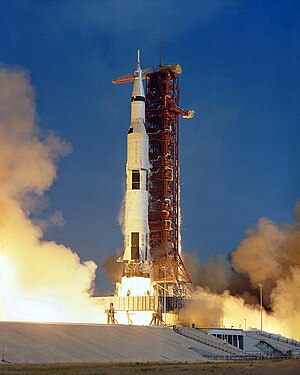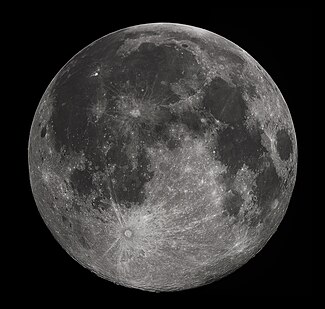Wikipedia:WikiProject Space 2019/POTD
This is a staging area. Please go to the talk page for discussion.
| WikiProject Space 2019 | ||||
|---|---|---|---|---|
|
|
|
|
|
|
|
| ||||
July 16

|
The Saturn V SA-506 carrying Apollo 11, the first crewed lunar landing mission, on July 16, 1969, at 13:32 UTC. Launching from Launch Pad 39A at Florida's Kennedy Space Center, the five Rocketdyne F-1 engines of the rocket's S-IC first stage can be seen arrayed in a quincunx, with a fixed center engine and four outer engines that gimballed for steering. A multistage liquid-fuel expendable launcher, the Saturn V was designed under the direction of Wernher von Braun at the Marshall Space Flight Center. It was the largest production model of the Saturn family, with a height of 111 m (363 ft), although larger models were theorized. The super heavy-lift launch vehicle consisted of liquid-propellant rockets in three stages, the first of which had a total mass at launch of 2.3 million kilograms (5.1 million pounds), consisting mostly of its RP-1 fuel and liquid oxygen. As well as launching Apollo missions, the Saturn V also launched the Skylab space station. Thirteen rockets were launched from 1967 to 1973, with an almost perfect launch record – Apollo 6 and Apollo 13 did lose engines, but the onboard computers were able to compensate. Photograph credit: NASA; retouched by PawełMM
Recently featured:
|
July 18

|
The Moon is the only natural satellite of Earth and the fifth largest moon in the Solar System. Owing to its synchronous rotation around Earth, the Moon always shows essentially the same face: its near side, which is marked by dark volcanic maria, as well as the bright ancient crustal highlands and the prominent impact craters. However, variations in the Moon's orbital speed due to its orbital eccentricity cause a libration of several degrees of longitude; the alignment of the Moon's orbital plane causes a similar libration in latitude. The Moon was first reached in September 1959 by the Soviet Union's unmanned Luna 2, followed by the first successful soft landing by Luna 9 in 1966. The United States Apollo program achieved the only manned lunar missions to date, including Apollo 8 in 1968, the first manned orbital mission, as well as Apollo 11, the first of six manned landings between 1969 and 1972. This picture shows the near side of the Moon close to its greatest northern ecliptic latitude, so the southern craters are especially prominent. Tranquility Base, Apollo 11's landing site, is located near the mid-right in the photograph. Photograph credit: Gregory H. Revera
Recently featured:
|
July 20

|
The Parkes Observatory is a radio telescope observatory in New South Wales, Australia, located 20 kilometres (12 mi) north of the town of Parkes. It was one of several radio antennae used to receive live television images of the Apollo 11 Moon landing on 20–21 July 1969. Its scientific contributions over the decades has led the Australian Broadcasting Corporation to describe it as "the most successful scientific instrument ever built in Australia" after 50 years of operation. The observatory, which opened in 1961, is run by the Commonwealth Scientific and Industrial Research Organisation (CSIRO), an independent Australian federal government agency, as part of the Australia Telescope National Facility network of radio telescopes. It is frequently operated together with other CSIRO radio telescopes to form a very-long-baseline interferometry array. This picture, taken in 1969, shows the Parkes Observatory's main 64-metre (210 ft) diameter radio telescope dish, around the time that it received transmissions from Apollo 11, with a crescent moon visible in the background. The photograph is part of CSIRO's ScienceImage archive. Photograph credit: CSIRO
Recently featured:
|
July 21

|
Apollo 11 was the fifth crewed mission of NASA's Apollo program. After launching from the Kennedy Space Center in Florida on July 16, 1969, commander Neil Armstrong and Apollo Lunar Module pilot Buzz Aldrin landed Eagle in Mare Tranquillitatis on July 20, at 20:17:40 UTC, while command module pilot Michael Collins remained on Columbia in lunar orbit. Armstrong was the first to exit the spacecraft, stepping onto the surface 6 hours and 39 minutes later, on July 21, at 02:56:15 UTC; nineteen minutes later, Aldrin joined him on extravehicular activity, which lasted 2 hours, 31 minutes and 40 seconds. Armstrong and Aldrin lifted off from Tranquility Base after almost 22 hours on the lunar surface and rejoined Collins in the command module, before splashing down in the Pacific Ocean on July 24. The mission was planned to the minute, with the majority of the photographic tasks performed by Armstrong with a single Hasselblad camera. Most of the photographs taken on the Moon that include an astronaut are of Aldrin; there are only five images of Armstrong partly shown or reflected, as in this photograph, with Armstrong and the lunar module reflected in Aldrin's helmet visor. "As the sequence of lunar operations evolved," Aldrin explained, "Neil had the camera most of the time [...] It wasn't until we were back on Earth and in the Lunar Receiving Laboratory looking over the pictures that we realized there were few pictures of Neil." Photograph credit: Neil Armstrong
Recently featured:
|
July 24

|
The Sun is the star at the center of the Solar System. It is a nearly perfect sphere of plasma, heated by nuclear fusion of hydrogen into helium in its core, with internal convective motion that generates a magnetic field via a dynamo process. It is by far the most important source of energy for life on Earth. Its diameter is about 1.39 million kilometres (860,000 miles) or 109 times that of Earth, while its mass is about 330,000 times that of Earth. It accounts for about 99.86% of the total mass of the Solar System. Roughly three-quarters of the Sun's mass consists of hydrogen; the rest is mostly helium, with much smaller quantities of heavier elements, including oxygen, carbon, neon and iron. This false-color photograph of the Sun was taken by the Atmospheric Imaging Assembly instrument on NASA's Solar Dynamics Observatory (SDO) at a wavelength of 304 angstroms, in the extreme ultraviolet region of the electromagnetic spectrum.
Recently featured:
|





